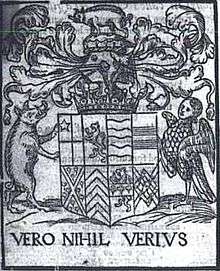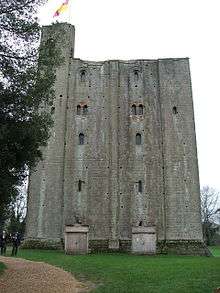Earl of Oxford

Earl of Oxford is a dormant title in the Peerage of England, first created for Edgar the Atheling and held by him from 1066 to 1068, then recreated and held for more than five and a half centuries by the De Vere family from 1141 until the death of the 20th Earl in 1703. The Earls of Oxford were also hereditary holders of the office of Lord Great Chamberlain from 1133 until the death of the 18th Earl in 1625. Their primary seat was Castle Hedingham in Essex, but they held lands across England, particularly in eastern England. The actual name was 'Oxenford' until at least the end of the 17th century. Medieval sources thus refer to 'my lord of Oxenford' when speaking of the earl.
Earls of Oxford (1141)

The 3rd Earl was one of the 25 barons of Magna Carta. The 9th Earl was a favorite of King Richard II and was created Duke of Ireland. The 13th Earl was a Lancastrian during the War of the Roses and Henry Tudor's commander at the Battle of Bosworth Field in 1485.[1] The 17th Earl has become the most famous of the line because of his emergence as a popular alternative candidate as the actual author of the works of William Shakespeare (see Oxfordian theory of Shakespeare authorship). The 17th Earl was a ward and later son-in-law of Lord Burghley, Queen Elizabeth I's Secretary of State. On the death of the 20th Earl, without identifiable heirs male, the title became dormant.
The Earls of Oxford held no subsidiary titles, and so their heirs apparent were styled by invented courtesy titles: initially Lord Vere, and later Viscount Bolebec (sometimes spelled Viscount Bulbeck).
The principal Oxford coat of arms or shield was quarterly gules and or (red and yellow) with an argent (white) five-pointed star called a mullet or molet in the first canton. By De Vere family tradition this molet is said to refer to a reappearance of the Star of Bethlehem which showed itself to an earlier De Vere while on a Crusade and thus led him to victory. In the 14th and 15th centuries the family livery worn by their retainers was orange/tawney decorated with a white molet. A later badge associated with the De Veres is a blue boar. A later shield variation of the De Vere white molet has a smaller blue molet located within the white one but this may be a simple cadency mark - in heraldry the molet is also used in any family to indicate the third son of a title holder. The third son bears his father's arms differenced with a molet.
A confusion between the De Vere white molet and Edward IV's sunburst and white rose is said to have led to the friendly fire incident between Neville men and De Vere's men at the Battle of Barnet in 1471. Fighting in fog, the Nevilles (former Yorkists) fired on their De Vere (staunch Lancastrian) allies and thus brought about the collapse of the Lancastrian centre and right. Both contingents began to rout crying 'treachery'.
List of title holders
First Creation (1066)
- Edgar the Ætheling, 1st Earl of Oxford, first creation, (1066-1068)
Second Creation (1141)
- Aubrey de Vere, 1st Earl of Oxford, second creation, (c. 1115–1194)
- Aubrey de Vere, 2nd Earl of Oxford (c. 1164–1214)
- Robert de Vere, 3rd Earl of Oxford (c. 1173–1221)
- Hugh de Vere, 4th Earl of Oxford (c. 1208–1263)
- Robert de Vere, 5th Earl of Oxford (1240–1296) (forfeit 1265, restored soon after)
- Robert de Vere, 6th Earl of Oxford (1257–1331)
- John de Vere, 7th Earl of Oxford (1312–1360)
- Thomas de Vere, 8th Earl of Oxford (1337–1371)
- Robert de Vere, 9th Earl of Oxford (1362–1392) (forfeit 1388)
- Aubrey de Vere, 10th Earl of Oxford (1340–1400) (restored 1393)
- Richard de Vere, 11th Earl of Oxford (1385–1417)
- John de Vere, 12th Earl of Oxford (1408–1462)
- John de Vere, 13th Earl of Oxford (1442–1513) (forfeit 1475, restored 1485)
- John de Vere, 14th Earl of Oxford (1499–1526)
- John de Vere, 15th Earl of Oxford (1482–1540)
- John de Vere, 16th Earl of Oxford (1516–1562)
- Edward de Vere, 17th Earl of Oxford (1550–1604)
- Henry de Vere, 18th Earl of Oxford (1593–1625)
- Robert de Vere, 19th Earl of Oxford (1575–1632)
- Aubrey de Vere, 20th Earl of Oxford (1627–1703) (dormant 1703)
| Aubrey de Vere 1st Earl (d. 1194) | |||||||||||||||||||||||||||||||
| Aubrey de Vere 2nd Earl (d. 1214) | Robert de Vere 3rd Earl (d. 1221) | ||||||||||||||||||||||||||||||
| Hugh de Vere 4th Earl (d. 1263) | |||||||||||||||||||||||||||||||
| Robert de Vere 5th Earl (d. 1296) | |||||||||||||||||||||||||||||||
| Robert de Vere 6th Earl (1257–1331) | Alfonso de Vere (d. 1328) | ||||||||||||||||||||||||||||||
| John de Vere 7th Earl (1312–1360) | |||||||||||||||||||||||||||||||
| Thomas de Vere 8th Earl (d. 1371) | Aubrey de Vere 10th Earl (1338–1400) | ||||||||||||||||||||||||||||||
| Robert de Vere 9th Earl (1362–1392) | Richard de Vere 11th Earl (1385–1417) | ||||||||||||||||||||||||||||||
| John de Vere 12th Earl (1408–1462) | Robert de Vere | ||||||||||||||||||||||||||||||
| John de Vere 13th Earl (1442–1513) | George de Vere | John de Vere | |||||||||||||||||||||||||||||
| John de Vere 14th Earl (1499–1526) | John de Vere 15th Earl (d. 1540) | ||||||||||||||||||||||||||||||
| John de Vere 16th Earl (1516–1562) | Aubrey de Vere (b. 1519) | ||||||||||||||||||||||||||||||
| Edward de Vere 17th Earl (1550–1604) | Hugh de Vere | ||||||||||||||||||||||||||||||
| Henry de Vere 18th Earl (1593–1625) | Robert de Vere 19th Earl (1575–1632) | ||||||||||||||||||||||||||||||
| Aubrey de Vere 20th Earl (1627–1703) | |||||||||||||||||||||||||||||||
Earls of Oxford and Earl Mortimer (1711)
The title Earl of Oxford and Earl Mortimer was created in the Peerage of Great Britain for Robert Harley in 1711. It became extinct in 1853.
Earls of Oxford and Asquith (1925)
After the extinction of the Earls of Oxford and Earls Mortimer, Asquith was keen to choose "Earl of Oxford" for his own title. As an earldom was then traditional for former Prime Ministers, and Asquith had a number of connections with the city of Oxford, it seemed a logical choice and had the King's support. The proposal greatly offended the relatives of the dormant Earldom, however, and, in the face of their opposition, another title had to be chosen — "Earl of Oxford and Asquith". For information on this creation, see Earl of Oxford and Asquith.
References
- ↑ G. E. Cokayne, et al., eds., The Complete Peerage, 2nd ed., vol. 10.
Further reading
- Anderson, Verily. The De Veres of Castle Hedingham. Lavenham, Suffolk: Terence Dalton, 1993.
- Sir Clements R . Markham "The Fighting Veres" Lives of Sir Francis & Lord Horace Vere, Generals of the Queen's Forces(1888)The Fighting Veres (CSV/Text)
External links
![]() Media related to Earls of Oxford at Wikimedia Commons
Media related to Earls of Oxford at Wikimedia Commons